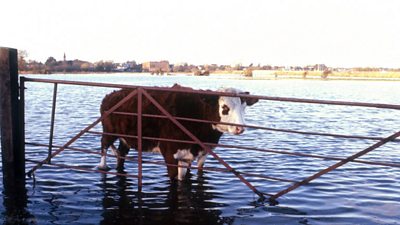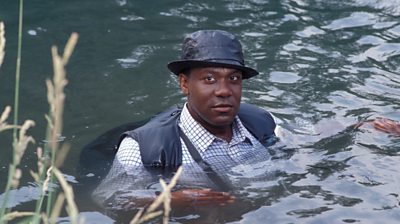See our separate Guide for for those working in Boats.
What Can Go Wrong?
- Slip or trip at the waterβs edge, on pontoons, quaysides, when crossing boats and falling into water or drowning.
- Fall overboard or drown, or be injured by moving boat.
- Hit by a moving vehicle or load around docks/ ports/ harbour.
- Vehicles, support, grips equipment falling into the water from unmarked edges, docksides, harbour walls and unstable banks etc.
- Stranded or washed away due to incoming tides, rising flood waters or boat wakes.
- Extreme weather (exposure to direct sunlight/ heat, cold).
- Electric shock from use of electrical equipment.
- Infections from ratsβ urine such as Weils disease (Leptospirosis).
Legal/ΒιΆΉΤΌΕΔ Requirements
- There may be licencing conditions for any waterway or lakes, check with the relevant agency. (Environment Agency, Maritime and Coastguard Agency, Port of London Authority etc.) Be aware that different restrictions can apply on even the same waterways when working in harbours/ marinas or, when filming internationally.
- There are specific requirements when working with Boats see the Boats: Working on page
- If in any doubt, speak to ΒιΆΉΤΌΕΔ Safety when planning such activities.
Control Measures
General Controls
- Ensure you are working a sufficient distance from the waterβs edge.
- Wear suitable flat robust shoes with non-slip soles.
- Be aware of trip hazards at the waterβs edge and remove where possible.
- Understand the local emergency plans. Develop rescue plans if there is a risk of falling into the water.
- Wear life jackets or buoyancy aids where there is a risk of entering water. Choose the correct life jacket for the conditions eg, manual or automatic inflation and make sure it is fitted correctly (see Recommended Links - RNLI video)
- Wear waterproof clothing suitable for location / weather conditions and take spare clothes are taken if likely to get wet.
- Use battery powered equipment wherever possible. Where mains power is used, ensure cables, sockets etc. are suitable for the environment (Ingress Protection, IP, rated for water) and connected through a residual current device (RCD).
- Brief crew to ensure any cuts or abrasions are covered with waterproof dressings to avoid any risk of infection
- Use good personal hygiene.
- Ensure the teamβs immunisations are up to date and staff knows the signs and symptoms of leptospirosis or Hepatitis A when working on or near flood waters, sewers and rivers.
- Plan breaks and hot drinks in warm places, if weather is wet / cold.
Ports, harbours and docksides
- Find out site rules and prohibited areas with harbour masters, port authorities and local experts. Keep 2 metres from the edges of docks, harbour walls etc.
- Ensure where required, supervision by local authorities.
- Check to see if there are any vehicle and crane movements in the areas that you wish to work.
- Observe & adhere to all the road signage and speed restrictions.
- Be aware of all ropes & chains trailing across walkways.
- Be aware of oils and greasy surfaces.
- Site rules may require high-viz vest and steel toes caps when working on docks.
- Seek advice on further protection measure that may be required from Health Protection Agency or Environment Agency for example, when filming near rivers or sewers.
Swimming Pools
- Around swimming pools wear plastic non-slip βinsideβ shoes.
- Consider arranging a suitably qualified lifeguard.
Tides and Coastal Surge Risks
- See our separate Guide to Floods and Coastal Surges.
Division Specific Issues
- Incorporating Radio OB MS M024-09 Working On or Near Water.
FAQs/Did You Know?
- Safety stores provide a range of safety equipment and wet weather gear suitable for outdoor and boat use.
- Buoyancy aids are not life jackets and wonβt support an unconscious casualty face up in the water or provide as much lift, so think carefully about the specific life saving protection required.
Recommended links
-
[Gateway]
-
-
-
-
-
-
-
Water topics
-

Water: Working On or Near
Guidance to working on or near water. -

Boats: Working on
A guide to working and filming from boats. -

Diving
A Guide to Scuba Diving and free Diving in both open water and pools. -

Floods and Coastal Surges
A guide to inland floods. -

Legionella in Premises: Control of
This guidance provides an overview of how water systems are managed in premises to minimise the risks from the Legionella bacteria. -

Water and Waste Water Management
How to manage water and waste water arising from ΒιΆΉΤΌΕΔ activities -

Weather
The ΒιΆΉΤΌΕΔ regularly film and record outside, exposing staff to a variety of adverse and changeable weather conditions during the course of their work. Thunderstorms pose a particular threat to those working at height outdoors, or with raised masts on broadcast vehicles. -

Wearing Your Life Jacket
Life jackets save lives and should be worn where there is a risk of entering the water unintentionally.
More from SSR
-
Your platform to record accidents, risk assessments, assurance monitoring and inspections
-
Safety Equipment Stores
Just one number to call: 020 3614 5155 -
ΒιΆΉΤΌΕΔ Safety Guidelines
An A-Z of ΒιΆΉΤΌΕΔ's Health and Safety Guidelines -
Safety Advice Line: 0370 411 0464 Email: safety@bbc.co.uk
- A-Z of ΒιΆΉΤΌΕΔ Safety Guidelines
- Accident Reporting and Investigation
- ΒιΆΉΤΌΕΔ Health & Safety Policy
- Contractors (incl. vetted lists)
- Contributors
- Fire Safety
- Freelancers
- Independent Production Companies
- Risk Assessment
- Safety Alerts
- Safety Responsibilities
- Safety Training
- Sets & Premises Safety Guide
Events guidance - key links:
- Exhibitions
- General Guidance
- Indoor Location Recce Checklist
- Outdoor Location Recce Checklist
- Major Incidents & Emergency Planning
- Marketing and Promotional
- Noise Exposure
- Planning and Management
- Responsibilities
- Responsibilities Form
- Laser Lighting Effects
- Strobe Lighting
- Temporary Stages and Rostra
Health topics - key links:
- (ΒιΆΉΤΌΕΔ network only)
- Contributors Fitness to Participate
- Display Screen Equipment (DSE)
- (ΒιΆΉΤΌΕΔ network only)
- First Aid and Welfare on Location
- International Travel - Risks & Health
- Manual Handling
- Mental Health: ΒιΆΉΤΌΕΔpage
- (ΒιΆΉΤΌΕΔ network only)
- Personal Health and Wellbeing
- Pregnancy
- Psychological Trauma Support & Trauma Risk Management (TRiM)
- Tiredness and Fatigue
- Travel Health Contacts
ΒιΆΉΤΌΕΔ High Risk - key links:
- CBRN and Industrial Spills
- Covert Filming
- Crisis Management and Security Support
- Demonstrations, Protests and Crowds
- Disaster Coverage
- Door Stepping
- (ΒιΆΉΤΌΕΔ network only)
- (ΒιΆΉΤΌΕΔ network only)
- Public Order
- Safety Equipment Stores
ΒιΆΉΤΌΕΔ Journalism - key links:
ΒιΆΉΤΌΕΔ Productions - key links:
- Aerial Filming and Airfields
- Animals: Displaying and handling for performance
- Boats: Working on
- Children and Young People
- Driving
- Electrical Equipment and Systems
- First Aid and Welfare on Location
- Food Safety (Cooking and Catering)
- Remote Location Working
- Roads and Streets: Working by
- Security of Productions on Location
- Stunts
- Tiredness and Fatigue
- Unmanned Aerial Systems (UAS aka Drones)
- Vehicles: Recording in, from and around
- Working at Height: Mobile Elevating Work Platforms
- Working at Height: Tower Scaffolds
ΒιΆΉΤΌΕΔ Radio - key links:
- (ΒιΆΉΤΌΕΔ Network only)
ΒιΆΉΤΌΕΔ Security - key links:
ΒιΆΉΤΌΕΔ Sport - key links:
About this site
This site describes what the ΒιΆΉΤΌΕΔ does in relation to managing its health, safety and security risks and is intended for those who work directly for the ΒιΆΉΤΌΕΔ.
It is not intended to provide instruction or guidance on how third parties should manage their risks. The ΒιΆΉΤΌΕΔ cannot be held liable for how this information is interpreted or used by third parties, nor provide any assurance that adopting it would provide any measure of legal compliance. More information
Some links on this site are only accessible when connected to the ΒιΆΉΤΌΕΔ network
